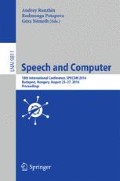Abstract
One of the most recently proposed techniques for modeling the prosody of an utterance is the decomposition of its pitch, duration and/or energy contour into physiologically motivated units called atoms, based on matching pursuit. Since this model is based on the physiology of the production of sentence intonation, it is essentially language independent. However, the intonation of an utterance in a particular language is obviously under the influence of factors of a predominantly linguistic nature. In this research, restricted to the case of American English with prosody annotated using standard ToBI conventions, we have shown that, under certain mild constraints, the positive and negative atoms identified in the pitch contour coincide very well with high and low pitch accents and phrase accents of ToBI. By giving a linguistic interpretation of the atom decomposition model, this research enables its practical use in domains such as speech synthesis or cross-lingual prosody transfer.
Access this chapter
Tax calculation will be finalised at checkout
Purchases are for personal use only
Notes
- 1.
Six recordings from the initial set of 910 recordings were excluded because they contained the ERROR tag where a boundary tone was expected.
References
Fujisaki, H., Nagashima, S.: A model for the synthesis of pitch contours of connected speech. Technical Report, Engineering Research Institute. University of Tokyo, Japan (1969)
Strik, H.: Physiological control and behaviour of the voice source in the production of prosody, Ph.D. thesis, Department of Language and Speech, University of Nijmegen, Netherlands (1994)
Kochanski, G.P., Shih, C.: Stem-ML: Language independent prosody description. In: International Conference on Spoken Language Processing (ICSLP), vol. 3, pp. 239–242 (2000)
Honnet, P.-E., Gerazov, B., Garner, P.N.: Atom decomposition-based intonation modeling. In: IEEE International Conference on Acoustics, Speech and Signal Processing – ICASSP (2015)
Gerazov, B., Honnet, P-E., Gjoreski, A., Garner, P.: Weighted correlation based atom decomposition intonation modeling. In: INTERSPEECH (2015)
Pierrehumbert, J.B.: The phonetics and phonology of English intonation (Ph.D. thesis). MIT, Cambridge, MA, USA (1980)
Silverman, K., Beckman, M., Pitrelli, J., Ostendorf, M., Wightman, C., Price, P., Pierre-humbert, J., Hirschberg, J.: ToBI: A standard for labeling English prosody. In: Proceedings of the International Conference on Spoken Language Processing (ICSLP), pp. 867–870 (1992)
Taylor, P.: Analysis and synthesis of intonation using the Tilt model. J. Acoust. Soc. Am. 107(3), 1697–1714 (2000)
Aubergé, V.: Prosody modeling with a dynamic lexicon of intonative forms: Application for text-to-speech synthesis. In: Proceedings of the ESCA Workshop on Prosody, pp. 62–65 (1993)
Holm, B,. Bailly G.: Generating prosody by superposing multi-parametric overlapping contours. In: Proceedings of the International Conference on Spoken Language Processing (ICSLP), pp. 203–206 (2000)
Kohler, K.J.: Studies in German intonation, Arbeitsberichte des Instituts für Phonetik und digitale Sprachverarbeitung. Universität Kiel, vol. 25, 295–360 (1991)
Kohler, K.J.: Parametric control of prosodic variables by symbolic input in TTS synthesis. In: van Santen, J., Sproat, R., Olive, J., Hirschberg, J. (eds.) Progress in Speech Synthesis, pp. 459–475. Springer, New York (1997)
Beckman, M.E., Hirschberg, J., Shattuck-Hufnagel, S.: The original ToBI system and the evolution of the ToBI framework. In: Jun, S.-A. (ed.) Prosodic Typology: The Phonology of Intonation and Phrasing, pp. 9–54. Oxford University Press, UK (2005)
Ostendorf, M., Price, P., Shattuck-Hufnagel, S.: The Boston University Radio News Corpus. Linguistic Data Consortium (1995)
Mallat, S.G., Zhang, Z.: Matching pursuits with time-frequency dictionaries. IEEE Trans. Signal Process. 41(12), 3397–3415 (1993)
Hermes, D.J.: Measuring the perceptual similarity of pitch contours. J. Speech Lang. Hear. Res. 41(1), 73–82 (1998)
Öhman, S.: Word and sentence intonation: A quantitative model. Speech Transmission Laboratory, Department of Speech Communication, Royal Institute of Technology (1967)
Prom-on, S., Xu, Y., Thipakorn, B.: Modeling tone and intonation in Mandarin and English as a process of target approximation. J. Acoust. Soc. Am. 125, 405–424 (2009)
Mixdorff, H.: A novel approach to the fully automatic extraction of Fujisaki model parameters. In: ICASSP 2000, vol. 3, pp. 1281–1284 (2000)
Acknowledgments
The presented study was supported in part by the Ministry of Education, Science and Technological Development of the Republic of Serbia (grant TR32035), and was carried out within the SCOPES project “SP2: SCOPES Project for Speech Prosody” (No. CRSII2-147611/1), supported by Swiss National Science Foundation. The authors are grateful to the company Speech Morphing, Inc. from Campbell, CA, USA, for providing the speech corpus used in the experiments.
Author information
Authors and Affiliations
Corresponding author
Editor information
Editors and Affiliations
Rights and permissions
Copyright information
© 2016 Springer International Publishing Switzerland
About this paper
Cite this paper
Delić, T., Gerazov, B., Popović, B., Sečujski, M. (2016). A Linguistic Interpretation of the Atom Decomposition of Fundamental Frequency Contour for American English. In: Ronzhin, A., Potapova, R., Németh, G. (eds) Speech and Computer. SPECOM 2016. Lecture Notes in Computer Science(), vol 9811. Springer, Cham. https://doi.org/10.1007/978-3-319-43958-7_6
Download citation
DOI: https://doi.org/10.1007/978-3-319-43958-7_6
Published:
Publisher Name: Springer, Cham
Print ISBN: 978-3-319-43957-0
Online ISBN: 978-3-319-43958-7
eBook Packages: Computer ScienceComputer Science (R0)

